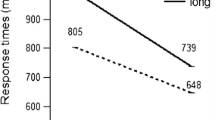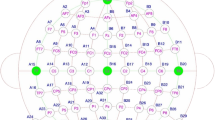Abstract
The Stroop test enables interference between color naming and reading to be studied. Protopapas et al. (2007) reported more errors in an interference task and longer reaction times in 12.5-year-old dyslexics; also more Stroop interference with lower reading skills. The present study uses a version of the Stroop with four color cards and aims to test interference and flexibility in older dyslexic teenagers. The four cards are: color naming, reading, interference and flexibility. In the latter, subjects have to name the color of the word inhibiting reading except when the word is inside a box. This flexibility task enables the testing of the capacity for cognitive switching between tasks. Ten dyslexics (15.1 ± 0.7 years old) and fourteen controls (14.3 ± 1.6 years old) participated in the study. All performed the color naming, the reading, the interference and the flexibility tasks in the same order. Subsequently, they performed a sequence of 60 saccades left–right followed by the interference task. Generally, dyslexic teenagers behaved similarly to non-dyslexics as they showed fewer errors in reading and color than in the interference and flexibility tasks. However, they made more errors and needed more time to accomplish each task than non-dyslexics. The results suggest that the inhibitory and attention processes required by the Stroop test are dysfunctioning even in older dyslexics. In contrast, the study shows no evidence for particular difficulty in the flexibility task, which would constitute an argument against problems with mental switching. Following the execution of saccades, errors in the interference test were significantly reduced for dyslexics, while the time was reduced for both groups. The effects are attributed to visual attention training via saccades.





Similar content being viewed by others
References
Alwitt LF (1966) Attention in a visual task among non-readers and readers. Percept Mot Skills 23:361–362
Bednarek DB, Tarnowski A, Grabowska A (2006) Latencies of stimulus-driven eye movements are shorter in dyslexic subjects. Brain Cogn 60:64–69
Boutin J, Gingras N, Rouleau N (2010) The nature of attentional dysfunctions in adolescents hospitalized for a first episode of psychosis. J Neuropsychol 4(Pt 1):47–70
Brosnan M, Demetre J, Hamill S, Robson K, Shepherd H, Cody G (2002) Executive functioning in adults and children with developmental dyslexia. Neuropsychologia 40:2144–2155
Bucci MP, Bremond-Gignac D, Kapoula Z (2008) Latency of saccades and vergence eye movements in dyslexic children. Exp Brain Res 188:1–12
Chevrie-Muller C, Simon AM, Fournier S (1997) Batterie Langage Oral Ecrit Memoire Attention (L2MP). Editions du Centre de Psychologie Appliquée, Paris
Christlman SD (2001) Bilateral eye movement reduces cortical activation asymmetries. EMDR International Association Conferences, Austin
Christman SD, Garvey KJ, Propper RE, Phaneuf KA (2003) Bilateral eye movements enhance the retrieval of episodic memories. Neuropsychology 17:221–229
Everatt J, Warner J, Miles TR (1997) The incidence of Stroop interference in dyslexia. Dyslexia 3:222–228
Faccioli C, Peru A, Rubini E, Tassinari G (2008) Poor readers but compelled to read: Stroop effects in developmental dyslexia. Child Neuropsychol 14:277–283
Fischer B, Hartnegg K (2000) Effects of visual training on saccade control in dyslexia. Perception 29:531–542
Helland T, Asbjornsen A (2000) Executive functions in dyslexia. Child Neuropsychol 6:37–48
Jensen AR, Rohwer WD Jr (1966) The Stroop color-word test: a review. Acta Psychol (Amst) 25:36–93
Kapoula Z, Bucci MP (2007) Postural control in dyslexic and non-dyslexic children. J Neurol 254:1174–1183
Leigh RJ, Zee DS (1999) The neurology of eye movement. Oxford University Press, New York
Logan GD (1997) Automaticity and reading: perspectives from the instance theory of automatization. Read Writ Q 13:123–146
Mac Leod C (1991) Half a century of research on the Stroop effect: an integrative review. Psychol Bull 109:163–203
Morton J, Chambers SM (1973) Selective attention to words and colors. Q J Exp Psychol 25:387–397
Posner MI (1978) Chronometric explorations of mind. Erlbaum, Hillsdale
Protopapas A, Archonti A, Skaloumbakas C (2007) Reading ability is negatively related to Stroop interference. Cogn Psychol 54:251–282
Riddell PM, Fowler MS, Stein JF (1990) Spatial discrimination in children with poor vergence control. Percept Mot Skills 70:707–718
Rizolatti G, Riggio L, DaScola I, Umilta C (1987) Reorienting attention across the horizontal and vertical meridians: evidence in favor of a premotor theory of attention. Neuropsychologie 25:31–40
Samuels SJ (1999) Developing reading fluency in learning-disabled students. In: Sternberg RJ, Spear-Swerling L (eds) Perspectives on learning disabilities: Biological, Cognitive, Contextual. Westview, Boulder
Stein JF, Riddell PM, Fowler MS (1987) Fine binocular control in dyslexic children. Eye 1(Pt 3):433–438
Stein JF, Riddell PM, Fowler S (1988) Disordered vergence control in dyslexic children. Br J Ophthalmol 72:162–166
Stoet G, Snyder LH (2007) Extensive practice does not eliminate human switch costs. Cogn Affect Behav Neurosci 7:192–197
Stuss DT, Floden D, Alexander MP, Levine B, Katz D (2001) Stroop performance in focal lesion patients: dissociation of processes and frontal lobe lesion location. Neuropsychologia 39(8):771–786
van der Schoot M, Licht R, Horsley TM, Sergeant JA (2000) Inhibitory deficits in reading disability depend on subtype: guessers but not spellers. Child Neuropsychol 6:297–312
Yeung N, Monsell S (2003) Switching between tasks of unequal familiarity: the role of stimulus-attribute and response-set selection. J Exp Psychol Hum Percept Perform 29:455–469
Author information
Authors and Affiliations
Corresponding author
Rights and permissions
About this article
Cite this article
Kapoula, Z., Lê, TT., Bonnet, A. et al. Poor Stroop performances in 15-year-old dyslexic teenagers. Exp Brain Res 203, 419–425 (2010). https://doi.org/10.1007/s00221-010-2247-x
Received:
Accepted:
Published:
Issue Date:
DOI: https://doi.org/10.1007/s00221-010-2247-x




